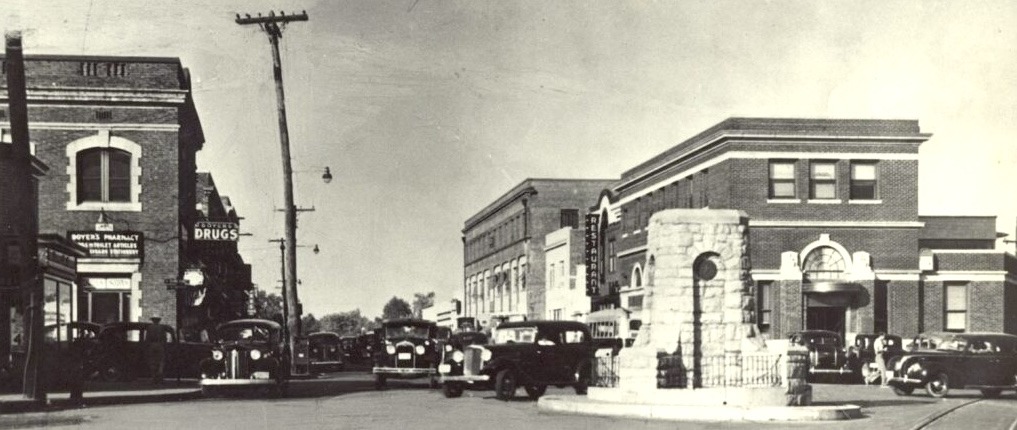In March 1920, Arlington county was officially renamed. It had been called Alexandria County since 1846 when the county was retroceded back to Virginia and was no longer the southwest part of the diamond that Washington, D.C. was designed to be.
As Alexandria County, we began to grow a LOT. It grew increasingly confusing to identify if an address was in Alexandria City or County so the county was renamed to be Arlington.
What kind of community was the newly named Arlington becoming? We dug through the AHS artifact collection and found many objects that were from that decade. Many were donated by Arlington residents over the years. We selected 13 artifacts that we think help form a picture of us from a distance of a century or so.
This temporary exhibit has been underway in the Arlington Historical Museum since February but now that the museum has closed because of the corona virus emergency, we wanted to share it with you nonetheless. So here it is from top left to bottom right of the exhibit.
Object #1
Fly Over Washington Potomac Flying Service Brochure
Brochure produced by the Potomac Flying Service as an advertisement, c. 1927

The Potomac Flying Service established in the spring of 1927, took more than 25,000 passengers for sightseeing flights over the nation’s capital by the end of 1928. By November of the same year, it had grown into the largest flying enterprise of its kind. It offered commercial aviation service—air taxi, sight-seeing, aerial photography, and flying instruction—for Washington. Passengers received certificates that affirmed they had, in fact, flown over the nation’s capital.
The company did very little traditional advertising in newspapers or magazines. Instead salaried representatives made daily visits to hotels and tourist hotspots such the Bureau of Engraving and Printing, the Washington Monument, and Arlington National Cemetery. They distributed leaflets and brochures like this one. The company also encouraged tour guides to mention the flying service and the company boasted in aviation trade journals that 500 DC taxi cabs had small advertising cards for their customers. They also provided news stories about their employees and their unique jobs, customers and their experiences, or flying students.


Henry A. Berliner (see image below) organized the Potomac Flying service and Lowell S. Harding was the general manager. Berliner was an aeronautical engineering graduate of the Massachusetts Institute of Technology–a new degree program started in 1914–and President of the Washington Chapter of the National Aeronautic Association. Harding was an experienced pilot and a veteran of World War I in the 93rd Air Squadron of the American Expeditionary Force.
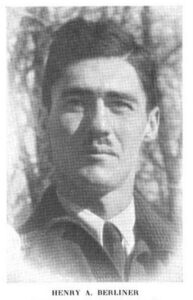
Berliner and other investors bought Hoover Field and built a hangar to manufacture more airships. The airfield had once been a horse racing track and was described as a “2,000′ x 800′ rectangular sod field with buildings on the southeast corner–including a roller coast & amusement park” known as Arlington Beach.
In 1928, Berliner sold the Potomac Flying Service and Hoover Field to E.W. Robinson who sold the business and the airfield to the National Aviation Corporation after the Great Depression. This corporation merged Hoover and the nearby Washington airfield into a new facility: the Washington-Hoover Airport.
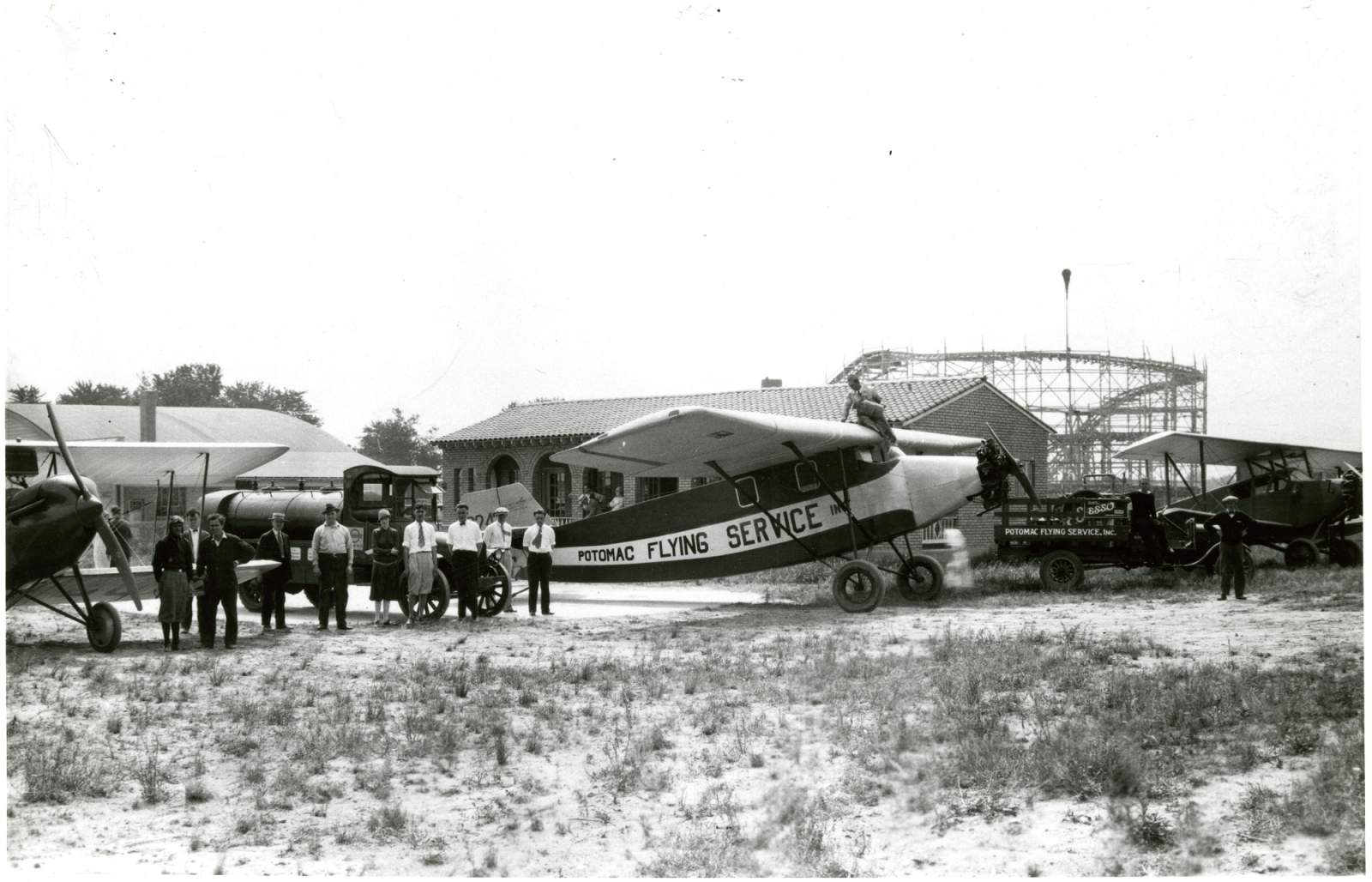
Object #2
Press Photo: Marie Duehring, Miss Arlington County
Photo taken on September 8, 1927 by Acme News Pictures

Marie Duehring, 17 was crowned Miss Arlington Heights. She went on to win the title of Miss Arlington on August 30, 1927. The county beauty contest was held at the Odd Fellows Hall in Clarendon and she competed against seven Arlington women from other neighborhood communities. The contest was sponsored by Arlington Post No. 139, the American Legion, and the Arlington Chamber of Commerce. She represented the county later in the month at the annual state convention of the Legion in Newport News. This press photo is credited to Acme News Pictures and was taken on September 8, 1927.
The first beauty contest recorded in the United States was sponsored by circus man, P.T. Barnum in 1854, but it was closed down by public protest. Beauty contests gained in popularity in the 1880s and were often sponsored by businesses to increase tourism. In 1921, the Miss America pageant began in Atlantic City and was fed by the consumerism of the 1920s.
Marie Duehring was born in 1910 in Washington, D.C. According to census data, she finished 10th grade but did not finish high school. In 1934, she married Melvin T. Young from Clarendon who was a US navy ensign and member of the class of 1932 at the US Naval Academy in Annapolis. He served in the US Navy’s Second Fleet and then in the reserves and eventually became a businessman who owned his own bicycle shop. The Youngs had two sons, James and Michael while Marie was a homemaker. The family lived in Arlington’s Maywood neighborhood at 2824 24th Street, North and had a live-in maid. In 1948, Marie was elected to serve as the Vice-President of the Woodlawn Home and School League—a forerunner of today’s Parent-Teacher Association. Marie died in 1968.
Object #3
West Electric Hair Curlers
Sales Advertisement and two curlers on cardboard card measuring 3 inches by 4 inches. c. 1923

The West Electric Hair Curler Company stated in ads in 1923 that over 50 million of their hair curlers were in use. This new gadget, a metal curler that open like a safety pin was patented in the 1920s and initially was marketed mainly to women with long hair. This card is from the early 1920s and features the image of a woman with longer hair. But in the 1920s, curler ads increasingly were aimed at women with “bobbed” or short haircuts.
On the card front under the curlers was an appeal to easily curl your hair by yourself at home without going to a hairdresser shop.
On the left the card reads: Wave or Curl hair in a few minutes without heat. Card of 2, 10 cents.
On the right the cardreads: Will not cut break or pull the hair. No sharp edges or points.
Under the curlers is printed brief directions on how to use them: Open and close like a safety pin.
And a further sales pitch: Make all the latest styles of coiffure. Used by good hair dressers everywhere.
The back of the card has step by step illustrated directions. For bobbed hair, the company advised:
-
- Hold
opened curler in right hand.
- Hold
-
- Take
strand of hair one inch from end between thumb and first finger, wind hair on
rounded end arm about three turns, hold hair in place with forefinger, roll
curler upward.
- Take
-
- Lock
the curler. (like a safety pin.)
- Lock
These curlers were packaged two curlers per card and sold in a box with five cards or the curers could be bought in pairs in the two-curler card. This enabled women to opt to curl all their hair or just frame their face with a few curls.

Object #4: African-American Raggedy Anne Doll
c. 1920 (Donated to AHS by Lou Ella Ingram and A. S. Furlow )

This African-American Raggedy Anne doll is a historically unique artifact in the AHS collection. The original label identifies it as a “Johnny Gruelle’s Own Raggedy Ann Doll” produced by Georgene Novelties, Inc.
Johnny Gruelle (1880-1937) entertained his daughter with drawings and stories about Raggedy Anne and Andy and created the iconic doll and her friends in the same style. However, available sources do not depict the doll on display here. Histories of the doll and the company that produced it show that the only “black Raggedy Ann” doll was named Belindy and had a stereotypical “black mammie” appearance that is nothing like this doll. This doll’s face, painted on dark flesh-toned material, like all Raggedy Anne dolls, has none of the denigrating facial features like Belindy’s that were common in the era’s depictions of African-Americans.

The tag confirms the dolls provenance as a Raggedy Anne doll and the doll may be a heretofore unknown variety. One theory by museum volunteer workers is that the buyer of the doll replaced the head of the doll to look more like its child owner.
Object #5: S&H Green Stamp Sewing Kit
c. 1926, Cardboard card opens with thread and sewing needles inside. Measures 3.5 inches by 4.5 inches. Produced by Joseph R. Bergey. (Donated to AHS by Ruth Ward)
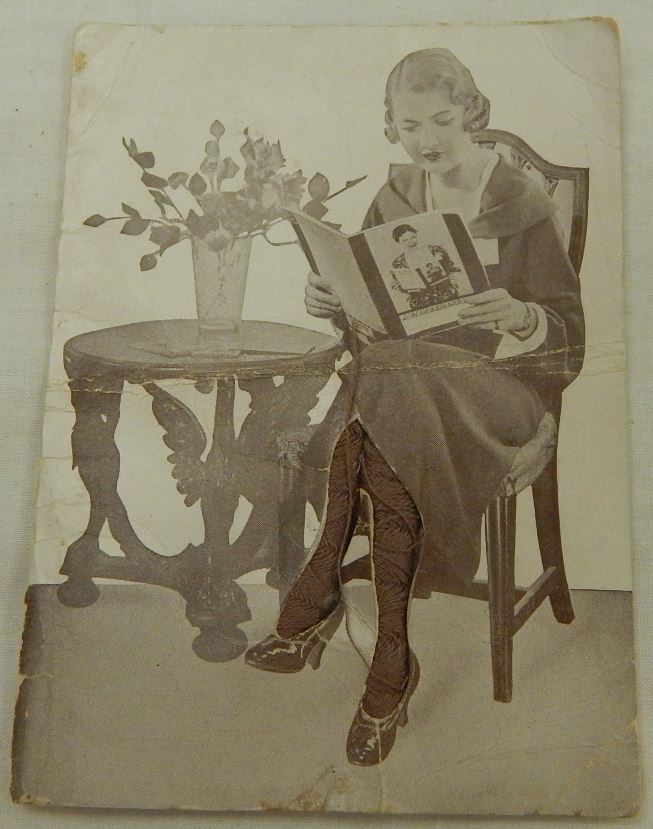

This sewing kit used by an Arlingtonian in the 1920s, is an example of clever, attractive marketing to women using an item that could make household chores easier and free up women’s time for more leisurely activities.
This sewing kit uses a patent from 1924 by John. L. Barry from Massachusetts who invented the way the thread was rolled into a skein and enabled the user to pull on it and unravel it as a single, tidy thread (see patent image below). The sewing kit displayed the thread on the cover in the legs of woman pictured sitting and reading which likely would have piqued the interest of the women perusing it. The sewing kit also offered a packet of Dix and Rands High Grade Sharps (size 3/9). The sewing kit was produced by the Joseph R. Bergey company which was located in the Garment District of New York City. The company must have produced thousands of these handy little housewife aids in partnership with Sperry and Hutchinson.
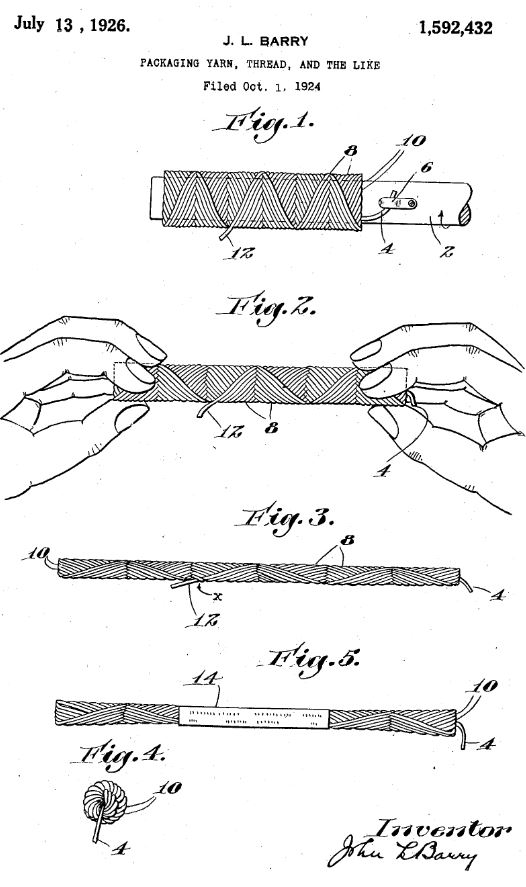
Inside the kit is also a place for the owner to affix a 10-point Sperry & Hutchinson Co-Operative Discount Stamp inside it. These stamps came to be known as S&H Green Stamps. Sperry & Hutchinson began in 1896 to offer stamps to US retailers such as grocery stores and gasoline filling stations. The stamps were issued in denominations of one, ten, and fifty points, perforated with a gummed reverse. As shoppers accumulated the stamps, they moistened the reverse and mounted them in collector’s books, which were provided free by S&H. Shoppers could then exchange filled books for housewares and other items from the local Green Stamps store or catalog. Each item or “premium” was assigned a value based on the number of filled stamp books required to obtain it. These Green Stamps were one of the first retail loyalty programs and proved successful for almost one hundred years because shoppers choose merchants who gave stamps over those that did not.
Object #6:
Fleron Official Boy Scout Signaler
Produced by M.M. Fleron and Sons, Inc. in the 1920s. Box contents include the metal Morse code signaler and pamphlet with Morse code key and information about how it was used. Box measures 3″ by 7.25″ by 2″ (Donated to AHS by Allen Ensign)

This telegraph practice set is an early metal version of later more popular plastic sets. These were widely distributed to Boy Scouts throughout the country and at least one Arlington boy scout played with it practicing to be a telegraph operator. Each set included the International Morse Code letter key and a pamphlet about its uses. This set allowed boys to practice communicating using codes in use by the military.
The Boy Scouts used the Fleron Signaler as their official signaler to train boys in Morse Code during the first half of the 20th century. This set allowed children to learn and play at being a signaler. Sold individually or in sets of two, Fleron Signalers could be hooked up together for sending and receiving messages with friends
Morse code was invented by Samuel Morse, who also invented the electric telegraph to transmit it. The telegraph key is a simple switch. Press it, and it triggers a receiver at the other end. All communication was reduced to long clacks, short clacks, and the time in between them.
Telegraphs were everywhere and until the 1920s were used more often than telephones for important business. Like today’s e-mail: a letter could be sent across the world in mere minutes. Skilled operators were well-paid and could send messages very quickly. Although not officially used today in the military, this simple method is still taught today.
Object #7
The Virginian, 1927
First Yearbook of Washington-Lee High School. (Donated to AHS by Sally Loving). You can peruse this yearbook from this link: The Virginian, 1927

Construction of Arlington’s first high school, Washington-Lee began in 1924 and the school opened on October 6, 1925. It graduated its first class in 1927 and this yearbook, The Virginian, was the first graduating class’s yearbook.
Before this school was built, county high school students attended public schools in Washington, D.C. or Alexandria City. Most Arlingtonians strongly opposed building a high school. Most of the county population, then about 20,000, worked in Washington and attended D.C. schools tuition-free; so they saw no need for a county high school. Through the efforts of School Superintendent Fletcher Kemp and other like-minded county citizens, voters were persuaded that a new high school in the county was needed. Arlington citizens voted in 1922 for school bonds to cover the building costs; this was the first time bonds were used to finance school construction in the state of Virginia.
The high school was originally named for two famous Virginians with local roots, George Washington and Robert E. Lee, and this first yearbook reflects that. The name Washington-Lee High School was formally adopted by the Arlington School Board on July 31, 1925. The yearbook name was changed from The Virginian to The Blue and Gray in 1928. More recently, change came again in 2019 when the school was renamed Washington-Liberty High School.

Object #8
Contract to Build a “Kit Home”
Between Builder Gaither & Hollway and Owner W. Glen Bixler at 614 South 23rd Street, Arlington. Signed on October 22, 1923. (Donated to AHS by W. Glen Bixler)

Several companies such as Montgomery Ward; Aladdin; and Sears, Roebuck, and Company offered catalog “kit houses” that were sold primarily through mail order either to the owner or to builders who then advertised their availability to homeowners. Regardless of whether Mr. Bixler bought if first for himself or from the builder, he hired a local company, Gaither & Hollway, to assemble it.
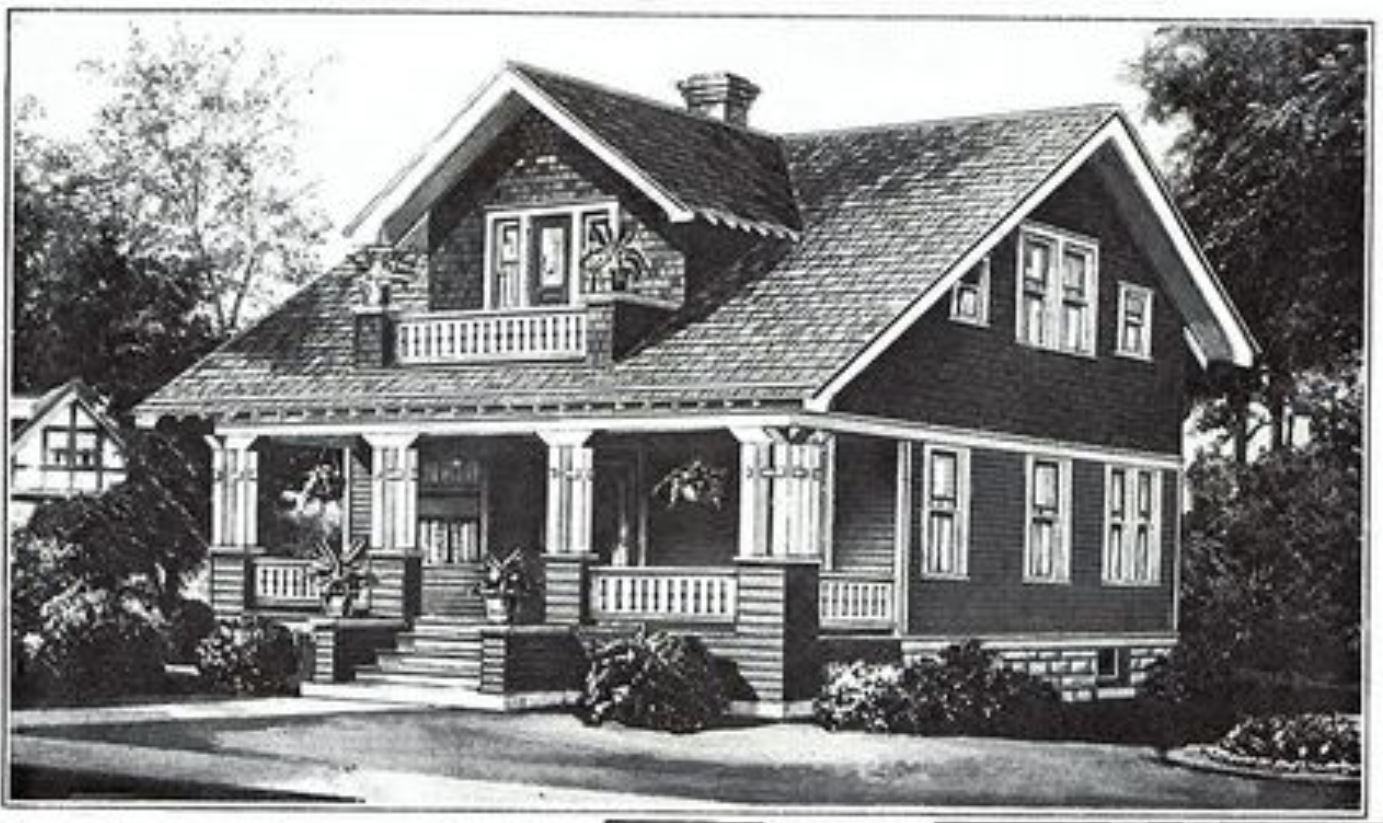

Although identifying a kit house by a photo is difficult, this house may be a model called “The Westly” produced by Sears. The Westly was small, inexpensive, and had a big front porch. According to Arlington kit home expert for the Smithsonian, Kathryn Holt Springston, noted local authority on kit homes, at least five Westly homes were built in Arlington. The homes were popular because of the low cost, convenient size, and ease of construction. They also often included the latest technology available to home buyers in the 1920s such as central heating, indoor plumbing, and electricity. Shipped to the building site, kits included most of the materials needed to build a house.
Walter Glen Bixler was born in 1898 in Rockingham County, Virginia. He moved to Washington, D.C. with his widowed mother and they rented a home. According to the 1920 census, he was a painter in the jewelry industry, but later he worked for decades for the Washington Evening Star newspaper. In 1918 married Ruth Stuart Howell and they had two daughters, Margaret and Louise. His mother also came to live with them in their Arlington home. He died in 1995.
Sears reported that it sold 370 different models; more than 70,000 of these homes were sold in North America between 1908 and 1940. Sears sales peaked in 1929, just before the Great Depression. The house still resembles the catalog image of “The Westly.” The owners were gracious in allowing AHS to photograph it for this exhibit.
Object #9
Scarlet Fever Quarantine Sign
Signed by P.M. Chichester, Arlington County Health Department, July 1, 1929. (Donated to AHS by Charles J. A. Johnson, Jr.)


Dr. Peyton M. Chichester, a doctor living in Clarendon with his wife and two children, became Arlington County’s second Health Department officer in 1924. On Jul 1, 1929, he authorized the quarantine of an Arlington site, probably a home, because someone had scarlet fever. Although newly treatable, scarlet fever was a leading cause of death for children in the early 20th century because of poor sewage disposal.
Dr. Chichester led county efforts to improve the health and safety of the county’s water supply and he launched a school vaccination program to help prevent the spread of communicable diseases like scarlet fever and typhoid. Inspired by the death of child that he could not save because the parents brought the child to him too late to help, he became a lifelong fervent advocate for helping children start their lives healthy so they could live longer healthier lives.

Dr. Chichester worked for the Arlington County health department until 1937, when he went to work for the Virginia state Health Department in Richmond. He died in 1961 in Richmond after more than 30 years of public service.
Object #10
Trophy for Best Commercial Float
Trophy, silver plated loving cup for best commercial float in the November 2, 1927 celebration of the opening of Arlington County Water System. (Donated by Henry Davis and Frank Ball) Engraved on the front are the words:
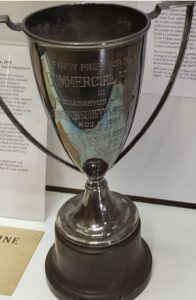
FIRST PRIZE FOR BEST
COMMERCIAL FLOAT
IN
THE CELEBRATION OF OPENING
ARLINGTON COUNTY WATER SYSTEM
NOV 3, 1927
WON BY
MASTER PLUMBERS ASSOCIATION
ARLINGTON COUNTY
DONATED BY
CHAMBER OF COMMERCE

Arlington County celebrated the opening of its water sewage system with a parade on November 3, 1927. This trophy was awarded to the Master Plumbers Association of Arlington County for the Best Commercial Float (pictured above).
Some Arlington communities such as Aurora Hills and Cherrydale had privately-owned companies providing them water, but most of the county got its water from individual wells. In 1922, Virginia passed legislation allowing the county to build a water and sewer system and later the US Congress authorized sale of federally-owned water to Arlington County and allowed the county to connect to the federal water system. This enabled the county to build a Lyonhurst water station in north Arlington. The Lyonhurst station in Lyon Village was equipped with a pump, a 260,000-gallon water tower, and a 1.5 million gallon reservoir. Water and sewage would not connect to every county community until the 1940s.
On November 3, 1927, public water supply service began to most of Arlington’s communities. The county declared a holiday and threw a Water Carnival in Lyon Village to celebrate with a parade, speeches, a fire hydrant demonstration, dancing, and fireworks.
(Details excerpted from “The Beginning of Arlington County’s Public Water Supply,” by Ruth P. Rose, Arlington Historical Magazine, 1977.)
Object #11
Application for Position of Federal Prohibition Agent
Completed by Z. O. Kines on March 18, 1925. (Donated to AHS by Sara Collins and Bette Clements.)

Zebulon Oliver Kines completed this application to be a federal enforcer of prohibition on March 18, 1925. He lived in Clarendon and was born in Fauquier County. He wrote that he had three children and was 174 lbs and 5’ 11 ½” tall. He stated that he was in “sound health” and had no defects in sight, hearing, speech, or limb. The application asked him the minimum salary he would accept and he wrote: $1800 which according to the information on the back of the form is at the higher end of the entrance salary ($1500-$1850) per year.
He did not fill in his education level but he supplied the fact that he was a private in the army during the Spanish-American War (1898) in the 3rd Virginia Volunteers from June to November 1898. He stated he did not use intoxicating beverages, morphine, or opium. When asked what his attitude toward the enforcement of Federal prohibition laws, he wrote: “I am in favor of the enforcement of the Federal laws.” All good answers for an applicant for this job.
He provided impressive references: Frank L. Ball: State Senator from Ballston; Honorable Samuel G. Brent, Esq: Circuit Court Judge in Alexandria City, and A. C. Clements: Arlington County Sheriff from 1920-1924.
From 1920 until 1927 the Prohibition Bureau was part of what is now the Internal Revenue Service and in 1927 it became an independent bureau in the Treasury Department. In the rush to get men into the field to raid bootlegging operations and speakeasies, the Treasury Department was often lax in their hiring standards. Mr. Kines was almost too qualified, as many agents were hired solely because they came recommended by one of the major prohibitionist lobbies, such as the Anti-Saloon League. They were underpaid, especially when bootleggers could afford sizable bribes. Still, many of the Bureau’s agents did their best to enforce the law, often coming up with ingenious disguises and ruses to bluff their way into speakeasies or to convince suspicious gangsters that they were genuine thirsty customers. The most famous Bureau agents today are “The Untouchables” from Chicago.
Object #12
Hill & Poole Pharmacy Pill Box
Cherrydale, Virginia, The prescription is typed inside the bill box. The box contained Luminal tablets prescribed for John Unger on August 13, 1929 by Dr. R. N. Sutton. The doctor’s instruction was for the patient to take one tablet three times a day. (Donated to AHS by Sharon Stoneburner.)
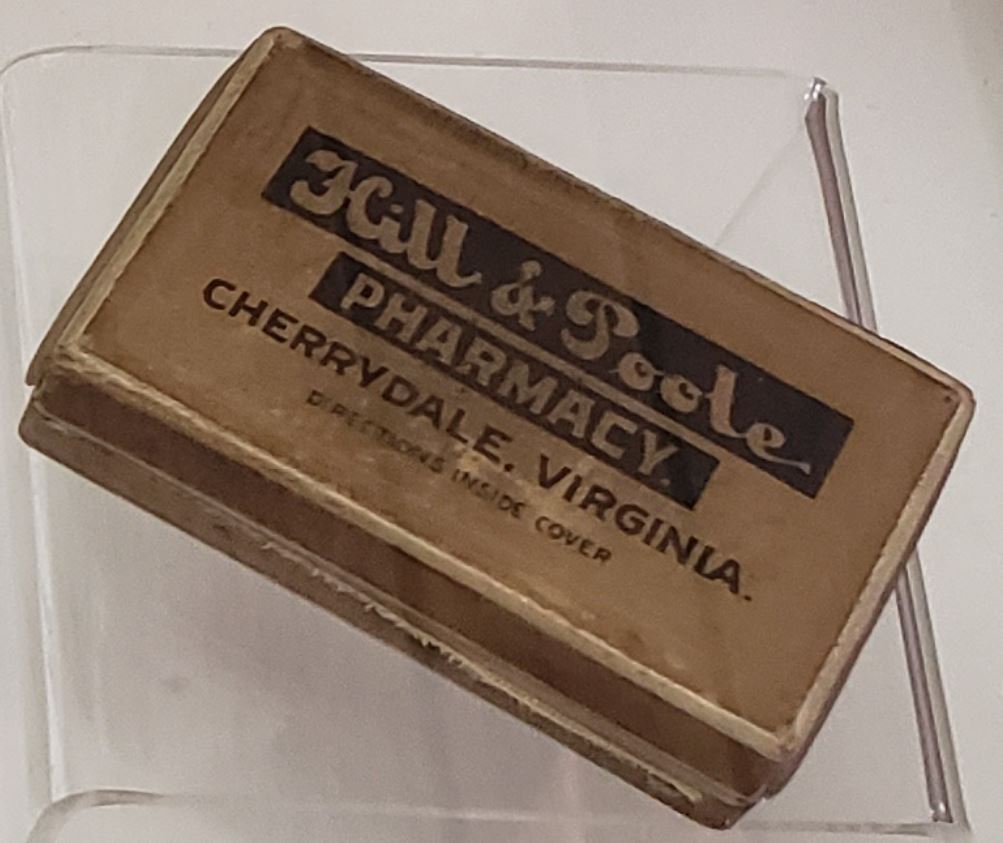
Dr. Richard N. Sutton, a Clarendon resident, was a prominent physician in Arlington County. He served as the deputy coroner and was an organizer of the Arlington Trust Company in the early 1920s, later becoming its Chairman of the Board.
Luminal is the trade name for the anti-epileptic drug, phenobarbital. It is a barbiturate used to quell epileptic seizures. In the 1920s it was just begin studied as an effective treatment.
Online Bonus Object!
Royal Blue Line Motor Tours Postcard
Produced by Curt Teich & Co., Chicago, U.S.A. c. 1925

Royal Blue Line Tours was a company that offered several tour routes and advertised with a postcard for each route. This postcard depicted the route to see key sites in Arlington including Arlington National Cemetery, Arlington House, and the “three sisters” wireless station at Fort Myer. The starting point for the tour was at Hotel Raleigh on Pennsylvania Avenue and 12st Street, N.W.
The company probably took its name from the Baltimore and Ohio Railroad (B&O)’s flagship passenger train service between New York City and Washington, D.C. which began in 1890 and was dubbed the Royal Blue Line. Initially using an early open-air autobus, the tour company updated its bus service to include windows and a heavier engine.
Thanks for viewing this virtual exhibit. When we reopen after the corona virus threat has passed, please visit the Arlington Historical Museum at 1805 South Arlington Ridge Road to see more of Arlington history, from Native Americans to 9/11.

